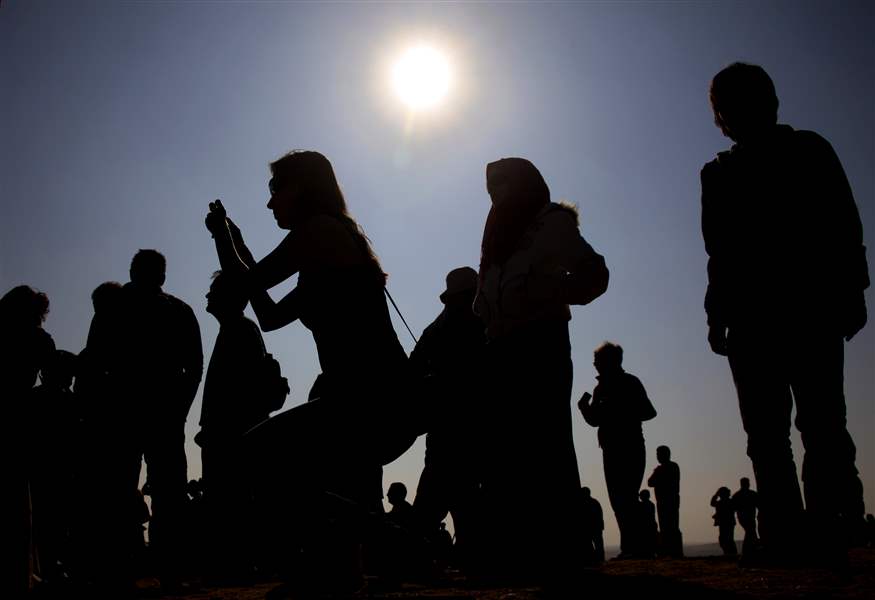
For some, eclipse inspires trips around the world
50,000-plus tourists expected to travel to Australia to see moon pass in front of sun Nov. 14
11/4/2012
Tourists take pictures in Egypt during a partial solar eclipse in January, 2011.
ASSOCIATED PRESS
MANAKIN-SABOT, Va. — When Linda Bugbee’s husband suggested traveling to the South Pacific to see a total solar eclipse, she was more enthusiastic about the cruise and visiting Tahiti than she was about seeing a celestial phenomenon.
Seven years later, Linda and George Bugbee, who live in Virginia, are embarking on their fourth trip to see a solar eclipse — this time in Australia, this month — but they still consider themselves “newbies.”
“It was a lot more emotional than I expected,” Linda said of their first eclipse. “Time sort of stops, but you know it’s only going to last a minute or so. You sort of take the universe and the planets for granted, but when this happens, it seems so real.”
Shortly after dawn on Nov. 14, the temperature will drop slightly in northern Australia and the sky will grow darker as the moon begins to pass in front of the sun. The Bugbees will look across the Coral Sea from the city of Cairns at 6:39 a.m. local time. Weather permitting, they will see a black disk with the sun’s glowing corona stretching beyond it. “Totality” — the darkness resulting from a total eclipse of the sun — will last just over two minutes.
Margaret Darveniza, regional development officer for Advance Cairns, said more than 50,000 tourists, up to half of them from overseas, are expected to travel to Australia to see the eclipse. Most will be in the Cairns-Port Douglas area in Queensland.
It’s unusual for a total eclipse to be visible from a resort area, said Kerri Anderson, spokesman for Tourism Queensland. Some hotels have been heavily booked for Nov. 14 for three years. About 5,000 tourists will stay in campers.
Visitors will view the eclipse from boats, trains, land — and even from hot air balloons.
Other stops
And many of them will take the opportunity to expand their itinerary to other destinations in the region. While they’re on the other side of the world, the Bugbees will also visit Sydney, Kakadu National Park, Yellow Water Billabong, Nourlangie Rock, and ancient rock sites in Uluru. At Cairns’ Green Island Resort, they’ll have opportunities to go snorkeling, windsurfing, canoeing, and taking nature walks. The tour will last nearly two weeks, and the Bugbees will extend their stay in Cairns by a few days. The region is known for its proximity to the Great Barrier Reef and the world’s oldest living rainforest, called Daintree.
George Bugbee, a retired anesthesiologist, has long been an astronomy enthusiast. Before the couple’s first trip to see an eclipse, he had watched recorded programs featuring Alex Filippenko, professor of astronomy at the University of California-Berkeley. Then he spotted an ad pitching an ocean cruise to see a complete solar eclipse with Filippenko as guest lecturer.
“I asked Linda if she wanted to go. She said no until she found out it was in the South Pacific,” he recalled, adding that the trip was “very suspenseful. It was cloudy. But with a boat, you can try to get away from the clouds. The sky cleared moments before the eclipse.”
He noted that shadows become razor sharp right before the eclipse. That first eclipse lasted 56 seconds. Others they’ve seen on subsequent eclipse trips have lasted as long as six minutes.
“Everyone gets really quiet,” said Linda Bugbee, a retired psychiatrist. “After people start seeing it for a few seconds, they start screaming and crying. When it’s over, the party starts. People start dancing and singing.”
She said that first eclipse made her think of the Bible passage about the sky turning dark immediately after Jesus died.
Egypt, Mongolia
The Bugbees’ other two trips to see eclipses were to Egypt in 2006 and to Mongolia in 2008. Their son, Matt, joined them on the trip to a remote area of northwest Mongolia, where they stayed in yurts — round, white tents — in a dry, barren region populated by nomads who move every few months in search of fresh pasture for their animals.
A number of tour companies specialize in organizing trips to see eclipses in various parts of the world. The Bugbees are using Melitatrips for their travel to Australia and went with Wilderness Travel for the Mongolia trip. They were among about 75 people watching the eclipse from that location. It lasted just over 2 minutes.
When the Bugbees went to Egypt, they viewed the eclipse with thousands of others, including then-President Hosni Mubarak. Groups were there from all over the world. The Bugbees remember a group from Norway in a tent that carried their country’s flag. They also remember being warned not to venture into a particular area because it was across the Libyan border and reportedly laced with land mines. When they traveled in Egypt, they were accompanied by armed guards.
They anticipate making many more trips to see solar eclipses in coming years and have met people who have witnessed 25 or 30 of them. The Bugbees are pleased that eclipses have led them to parts of the world they likely wouldn’t have visited otherwise. They are considering a trip to Morocco for an eclipse next year.
As for this year’s Australian eclipse, George Bugbee doesn’t expect it to be much different from the others, except that it will happen early in the day.
“I just hope it doesn’t rain,” he said.